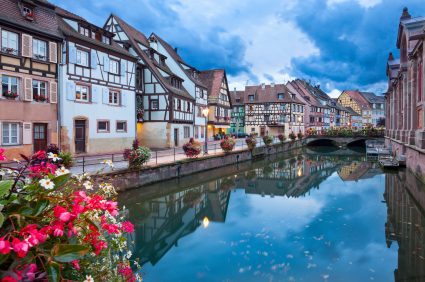Savoring the Wines of Alsace

One of my favorite wine tour memoriesis a bicycle trip through Alsace some forty years ago. It was a hot summer day, and we cycled through picturesque villages, some with storks nesting on the roofs of half-timbered houses. We came to the town of Riquewihr, and were welcomed at what local vintners called the “Riquewihr metro:” caves where the thirsty traveler could enjoy a cool, refreshing glass of Alsatian white wine.
I’m glad to say that the countryside remains scenic, with many attractions ranging from the Haut Koenigsberg castle, to the Wine Route that trails over 100 miles through the district, crossing the main wine producing areas from Thann to Marlenheim. It is a region of sad history, glorious wines, superb restaurants, and medieval villages. My favorite little town, Riquewihr, is on a par with St. Emilion for its beauty and history. Perhaps it will be your favorite discovery too.
The very bottles, called flûtes, long and tapered, are distinctive, cool and elegant. A couple of these bottles in a cooler filled with ice will quickly put your guests in a festive mood. And well they should be, for these wines go perfectly with summer fare. Let’s talk about them, and sort out the varieties. Remember that Alsatian wines are nearly all white wines, best served chilled.
For the taste of Alsace, I would start off with a bottle of Gentil from Hugel, a leading vintner of Alsatian wines (since 1639) and, I confess, my own favorite. Étienne Hugel confirms my judgment that this wine ($9.50) is the best way to start to appreciate fine Alsatian wines. It is a blend, and the majority of that blend is said to be from the “noble grapes,” Gewurztraminer, Riesling, Pinot Gris, and Sylvaner.
But most Alsatian wines are varietals, not blended wines. Gewurztraminer (“spicy traminer”), for example, is the wine to serve when you want to complement spicier dishes, like Thai, Cajun or Chinese spicy dishes (Szechuan or hotpot). It would also go well with curries.
We have always liked Sylvaner, but have sometimes had trouble finding it. It is a lighter style wine, just right for luncheon. When we lived in New England, we thought it went perfectly with fried clams or quahogs. Recently I sampled a bottle of 2005 Sipp Mack Sylvaner Vieilles Vignes ($14.50) and enjoyed its dry quality and citrus notes.
For many, Riesling is a summit, a sturdy and complex wine that can be served with a variety of foods, including the range of nobler fish (swordfish, salmon, perhaps turbot also, but you might prefer a Sylvaner for this more delicate flavor). The Lucien Albrecht Cuvée Henri 2007 ($33), a special Riesling named for the winemaker’s grandfather. It is one of a series of special cuvées made by Albrecht, which are of high quality, offering great value.
Pinot Gris is another substantial, quality wine that can be served with more complex dishes. Pinot Gris may be something of an acquired taste, like many good things. Try it with truffled dishes, or those featuring your favorite mushrooms. This varietal used to be called “Tokay d’Alsace,” although the wine had nothing in common with the famous Hungarian dessert wine. Also, don’t be put off by the cheaper varietal from other regions that you may already have tasted.
Over the years, there has been an evolution in Alsatian wines. We now have more château bottling, from tiny enclaves called “clos,” with their cost mounting to match the exclusivity. You may find that you enjoy these wines, particularly the estate-bottled Rieslings. But to start, and get a basic taste of Alsace, stick to varietal wines from a good supplier.
There are a number of excellent ones, in addition to Hugel. Trimbach is well known and appreciated broadly, for wines that are considered by many a bit more austere than those of Hugel. Lind-Humbrecht, Domaine Weinbach, Dopff, Lucien Albrecht and Schlumberger are also all fine producers.
For me, the pleasure of Alsatian wines is the simplest one. They are delicious and pleasant tasting. You’ll find as you go along and get to know them better that you’ll develop you own favorites and discoveries. Your Gewurztraminer Clos Windsbuhl from Zind-Humbrecht or Riesling Schlossberg Cuvee Ste. Catherine from Domaine Weinbach, or Hugel Riesling Jubilee (each in the $50-$60 a bottle range) may be your own discovery and standard of excellence. And the finest Alsatian dessert wines, such as Hugel’s Vendange Tardive (“VT”) 2007 ($57) or Selection de Grains Nobles (“SGN”) wines are of world class, like the best Sauternes.
But start off with a Gentil. You’ll be glad you did.
Sign up for our eNewsletter and receive our FREE wine tasting guide!


